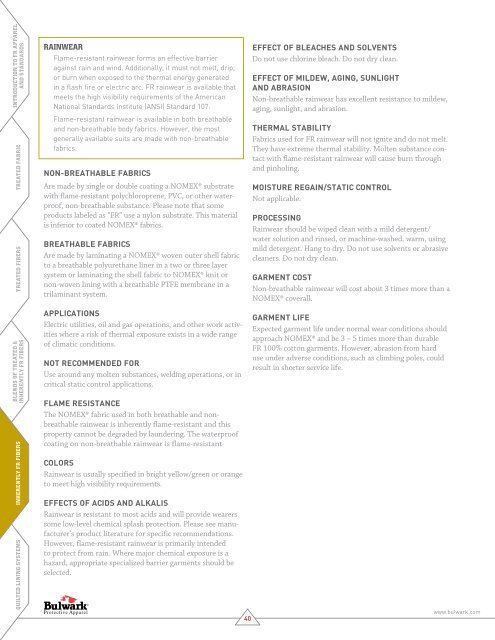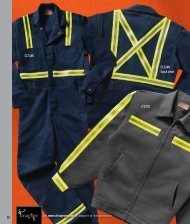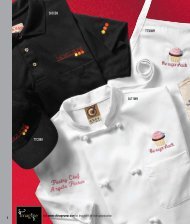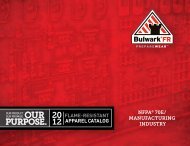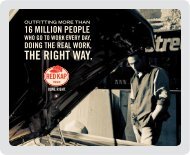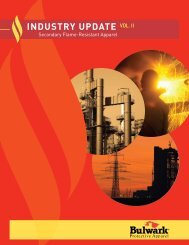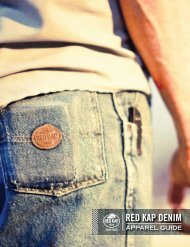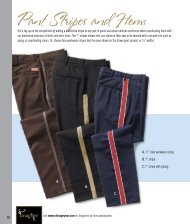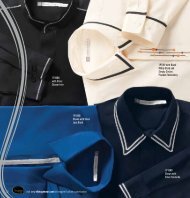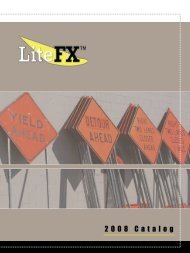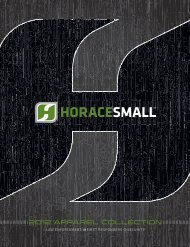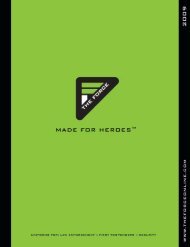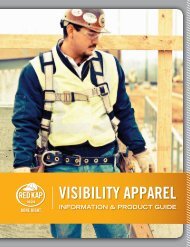VOL. 10 - Red Kap Work Clothes, Uniforms, & Coveralls
VOL. 10 - Red Kap Work Clothes, Uniforms, & Coveralls
VOL. 10 - Red Kap Work Clothes, Uniforms, & Coveralls
You also want an ePaper? Increase the reach of your titles
YUMPU automatically turns print PDFs into web optimized ePapers that Google loves.
introduction to fr apparel<br />
and standards<br />
treated fibers treated fabric<br />
RAINWEAR<br />
Flame-resistant rainwear forms an effective barrier<br />
against rain and wind. Additionally, it must not melt, drip,<br />
or burn when exposed to the thermal energy generated<br />
in a flash fire or electric arc. FR rainwear is available that<br />
meets the high visibility requirements of the American<br />
National Standards Institute (ANSI) Standard <strong>10</strong>7.<br />
Flame-resistant rainwear is available in both breathable<br />
and non-breathable body fabrics. However, the most<br />
generally available suits are made with non-breathable<br />
fabrics.<br />
Non-breathable Fabrics<br />
Are made by single or double coating a NOMEX® substrate<br />
with flame-resistant polychloroprene, PVC, or other waterproof,<br />
non-breathable substance. Please note that some<br />
products labeled as “FR” use a nylon substrate. This material<br />
is inferior to coated NOMEX® fabrics.<br />
Breathable Fabrics<br />
Are made by laminating a NOMEX® woven outer shell fabric<br />
to a breathable polyurethane liner in a two or three layer<br />
system or laminating the shell fabric to NOMEX® knit or<br />
non-woven lining with a breathable PTFE membrane in a<br />
trilaminant system.<br />
Effect of Bleaches and Solvents<br />
Do not use chlorine bleach. Do not dry clean.<br />
Effect of Mildew, Aging, Sunlight<br />
and Abrasion<br />
Non-breathable rainwear has excellent resistance to mildew,<br />
aging, sunlight, and abrasion.<br />
Thermal Stability<br />
Fabrics used for FR rainwear will not ignite and do not melt.<br />
They have extreme thermal stability. Molten substance contact<br />
with flame-resistant rainwear will cause burn through<br />
and pinholing.<br />
Moisture Regain/Static Control<br />
Not applicable.<br />
Processing<br />
Rainwear should be wiped clean with a mild detergent/<br />
water solution and rinsed, or machine-washed, warm, using<br />
mild detergent. Hang to dry. Do not use solvents or abrasive<br />
cleaners. Do not dry clean.<br />
Garment Cost<br />
Non-breathable rainwear will cost about 3 times more than a<br />
NOMEX® coverall.<br />
BLENDS OF TREATED &<br />
INHERENTLY FR FIBERS<br />
quilted lining systems INHERENTLY FR FIBERS<br />
Applications<br />
Electric utilities, oil and gas operations, and other work activities<br />
where a risk of thermal exposure exists in a wide range<br />
of climatic conditions.<br />
Not Recommended For<br />
Use around any molten substances, welding operations, or in<br />
critical static control applications.<br />
Flame Resistance<br />
The NOMEX® fabric used in both breathable and nonbreathable<br />
rainwear is inherently flame-resistant and this<br />
property cannot be degraded by laundering. The waterproof<br />
coating on non-breathable rainwear is flame-resistant<br />
Colors<br />
Rainwear is usually specified in bright yellow/green or orange<br />
to meet high visibility requirements.<br />
Effects of Acids and Alkalis<br />
Rainwear is resistant to most acids and will provide wearers<br />
some low-level chemical splash protection. Please see manufacturer’s<br />
product literature for specific recommendations.<br />
However, flame-resistant rainwear is primarily intended<br />
to protect from rain. Where major chemical exposure is a<br />
hazard, appropriate specialized barrier garments should be<br />
selected.<br />
40<br />
Garment Life<br />
Expected garment life under normal wear conditions should<br />
approach NOMEX® and be 3 – 5 times more than durable<br />
FR <strong>10</strong>0% cotton garments. However, abrasion from hard<br />
use under adverse conditions, such as climbing poles, could<br />
result in shorter service life.<br />
www.bulwark.com


